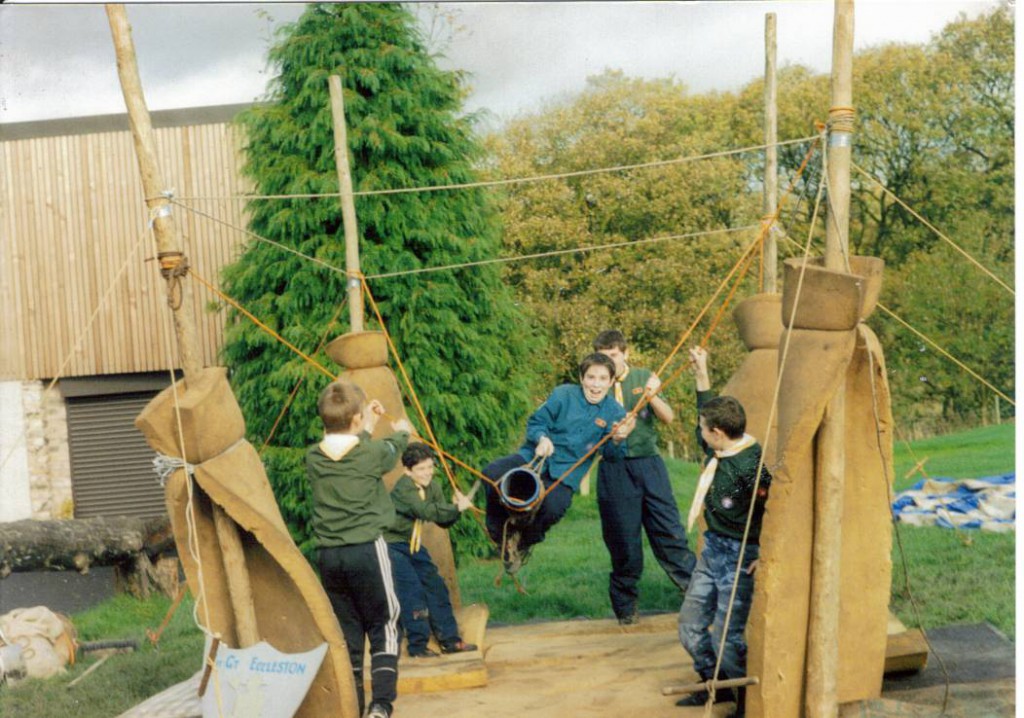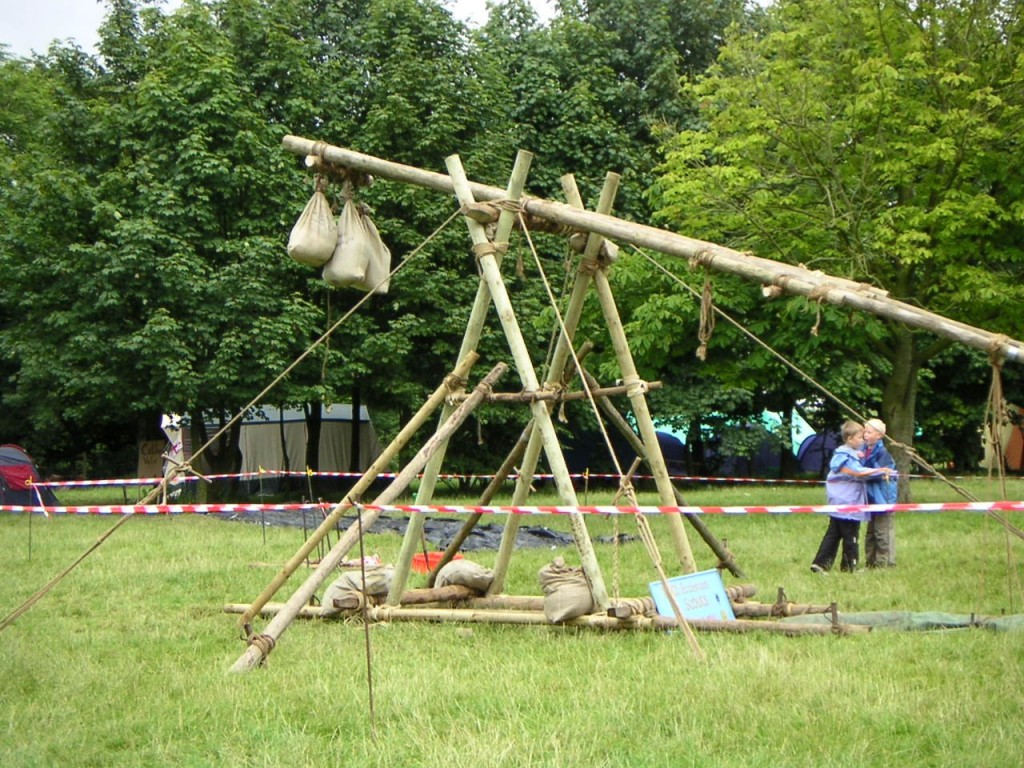Pioneering
What’s pioneering? When Lieut.-General R. S. S. Baden-Powell wrote Scouting for Boys, under the heading Camp Life chapter 4, he started by explaining that Pioneering is Knot-tying-Hut making Trees-Bridging-Measurements-Handicrafts. and that Pioneers are men who go ahead to open up a way in the jungles or elsewhere for those coming after them. During his time in Africa whilst commanding a large force of native scouts, they not only looked out for the enemy, but also improve the way forward for the main army following. In doing so they became pioneers as well as scouts and built nearly two hundred bridges of timber over streams. One of the things Baden-Powell learnt during this most important work was that out of the thousand men only sixty knew how to make knots and most of them didn’t know how to use an axe. So with this in mind one of the things a good scout should be able to do is know how to tie a number of simple knots and lashings, that will enable them to build a number of different pioneering structures.
It is important that you read this before attempting any pioneering project
Pioneering can be one of the most enjoyable, and rewording things a scout can do. Learning all the different knots and lashings can be a bit daunting at first, but once learnt the number of things you can do with this newfound skill is almost endless. But never forget that before you start any pioneering project, no matter how small, you must first consider all the safety aspects. Is your equipment suitable for the project, and in good condition. Are you competent enough to do the job, or do you need someone better trained than you to help? Never attempt to build something without proper supervision! Although pioneering is fun it can also be dangerous, you must never start anything without first doing a health and safety assessment.

Before we can start to learn how to tie knots, we must first learn the basic parts of a rope and what goes into making a knot/hitch. The Standing part, this is part of the rope that stands above a loop or bight, the opposite to the end. The End is the opposite to the standing part, the loose part of the rope. The Bight this is the name we give to an open circle or the middle of a rope. Finally the loop this is a closed circle in a rope that forms part of a knot. OK what is a knot? If its not a Bendthis is something that we use to tie one rope to another. andif its not a Hitch,something we use to fasten a rope to a post or other object, then its a knot. You can have a figure of Eight knot, this is probably the best known of all knots, and one what we term as a Stop knot,.
On the right is the Figure of Eight knot as described earlier and its tied on the end of a rope to stop it slipping through a loop or block. It can be used as a temporary knot to stop a rope fraying, and different forms of this knot are used by fishermen to secure the hook to the end of a line. If tied on the bight it makes e quick and easy loop.



The Reef Knot.
This is one of the most popular knots used for tying the ends of two ropes together. it can also be used in first aid for tying the ends of a sling, or bandage together. It’s a good knot to use because it will not jam, and is easy to untie. But this knot shouldn’t be used if the strain comes at an angle!
The Clove Hitch –right-
This is not a knot but a hitch, and is use at the beginning and end of most lashings. It’s also useful for fastening a rope to a post, because it will hold fast but can be easily untied by twisting it in the direction of what was the strain.


The Bowline left
This is an exceptional knot with a variety of uses, primarily used if you want a none slip knot in a rope to make a loop. It can be used as a waist loop to aid a rescue. or to secure a mooring line or as a haulage loop, there are a number of different tasks a Scout can use this knot for in competition work
If you look at it closely you will see its simply two loops, the first one sits over the standing end, and the second one is made by threading the end of the second loop through the first round the back of the standing end and then back through the loop.
Round turn and two half hitches

This is a very secure knot, and one I use to secure a rope to a post, or stake, when building bridges and towers. I also use it for fastening the end of a rope that will have to take a strain, usually from a pulley or block.
.Stunsails Bend
Although called a bend this is in actual fact a hitch, and as such can be used wherever you want to secure a rope to a spar.

The Sheet Bend
Like most bends its used to join two ropes together, this the single sheet bend is used with two ropes of equal thickness. Other uses are to secure a rope to a cable or hawser. If you look at it closely you will see its almost a reef knot

The Sheepshank
This is a knot that most Scouts are taught to tie but it is very rely used, only because its designed to shorten a rope without cutting it, something you don’t come across very often

Let’s look at some of the things you can do as a pioneering project, you could start with something simple like table top pioneering, all scouts can do this without much preparation. All that is needed is some twine, and some sticks gathered from a suitable bush or tree close to where you meet. No matter what you want to do, be it a bridge, or perhaps a trebuchet, by making a model first you can see if what you want to build is either possible, or practical full size.


Pioneering can open up a completely new world for your Scouts, its something they can all do together without a great deal of space or equipment, all you have to do is make it equally challenging and interesting and they will have lodes of fun doing it. One of the greatest tributes you can get as a Leader is, when a group of young people say to you after having completed for the first time ‘as a Patrol,’ a pioneering challenge during a competition. That was brilliant I wish our Leader would do things like that with us! Well what’s stopping you? Start simple and gradually work your way up to larger projects, learn to walk before you can run, and your confidence will grow as you become more competent. The other advantage of doing it this way is your equipment will grow according to your needs, and that way you will not waste money on things you don’t need, its no use having a store room full of equipment you cannot use!



As you become more competent you will want to build bigger and more complicated things, like the ones in these photos. My scouts have built a number of different things over the years, some of which have featured on television on a number of occasions. The Scouts are known for their pioneering demonstrations and displays at local fairs and shows, as a Leader I have been invited to set up, and judge, a number of pioneering challenges in District, and County, competitions. But the thing I like most is teaching both young and old pioneering principles, and better still watching the enjoyment they get out of building, and using them.

The Running Bowline
This makes a running noose and has saved the day for my Scouts on a number of occasions during competitions. If you have to pick an object up in an area you cannot enter, by placing two or three of these over it and gently pulling you can, with a bit of patience, pick it up.

The Fisherman’s Bend (right)
Again although this is called a bend its a hitch, if you look at it carefully you will see its very similar to the Round Turn and Two Half Hitches. the difference being the first half hitch goes round the standing part, and then through the round turn. What this dose is Make this hitch more secure, therefore its a lot safer than the round turn and two half hitches when you are using nylon or plastic rope, its also better of taking a grater strain

The Double Sheet Bend
This is a more secure version of this type of bend, and is better suited for fastening two ropes of different thickness together. The thing to remember when using ropes of different thickness, is that you always start with the loop in the thicker rope.

Ok we now have some knots to try, obviously there are lots more to do but that’s enough for now, we don’t want to get bored do we. So to make things a bit more interesting lets look at what we can do with some of the knots. Below there are some of the things we build, and do to make pioneering that bit more interesting. Hopefully they will give you a bit of inspiration or possibly you make things similar, if so you may find it interesting seeing how other Scouts build and use them.

Another thing to consider when teaching or starting a pioneering project is, you don’t have to be constructing large objects. (The number of Leaders who say to me ‘we don’t do pioneering because we haven’t got any pioneering poles’ never ceases to amaze me!) On the contrary pioneering can be something like a simple camp gadget made out of broom handles or small branches, or if you want to do something a bit more complicated, like the ones in the photos below, then you will need some small spars. The main consideration is the suitability of the project in comparison to the ability of your Scouts. Remember it’s got to be sufficiently challenging and not to complicated, and/or at least have a purpose, otherwise it will become boring.



Learn to build small bridges before going onto larger ones, they can be just as much fun to build and use, and you don’t have to lug all that extra equipment around. The other advantage is they are more appealing to younger people; the one above was built as part of a display at a local primary school.


Before and on the left After
Warning
Activities involving ropes can be dangerous. Therefore If you decide to replicate any of the activities, shown and described on these pages, they must be done under the supervision of a responsible instructor. When using knots the choice of materials; the age, size, and condition of ropes; and the accuracy with which you tie them is crucial. Also using the correct knot for the job, is just as important as maintaining all your pioneering equipment in first class condition. For this reason no responsibility can be accepted for incidents arising from the use of this material.
